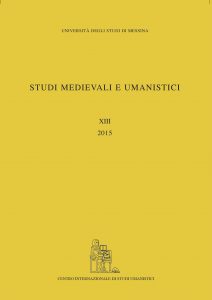XIII (2015)
Messina, Centro Internazionale di Studi Umanistici, 2015, 338 pp., tavv. XV; 25 cm.
ISSN 2035-3774
€ 120
INDICE GENERALE
Caterina Malta, L’ultimo tempo della meditatio historiae. Per la vicenda redazionale del terzo Triumphus Fame del Petrarca
Daniela Gionta, Epigrafia antica e ideologia politica nell’Italia del Quattrocento
Rossella Bianchi, Nella biblioteca di Angelo Colocci: libri già noti e nuove identificazioni
Paola de Capua, Pietro Corsi e l’ecloga Erasmus
Vincenzo Fera, Agostino Sottili e Petrarca
Laura Refe, In ricordo di Simona Mercuri
TESSERE
L. Orlandi, Escerti galenici nella biblioteca di Teodoro Gaza
C. Corfiati, ‘Nuove’ carte Michelozzi
D. Speranzi, La soluzione di un ‘enigma cretese’. Marco Musuro e il Par. gr. 2964
P. Megna, Problemi di metodo a proposito di una recente edizione polizianea
Indice delle tavole
Indice dei manoscritti e delle fonti d’archivio
Indice dei nomi
ABSTRACT
CATERINA MALTA, L’ultimo tempo della meditatio historiae. Per la vicenda redazionale del terzo
The paper aims at investigating the philological issue of the editorial history of the third Triumphus Fame. After the sixteenth-century debate, the entire issue was reopened (with contrasting views that lasted till the present age) thanks to the discovery, made in 1950 by R. Weiss, of a copy of the third Tr. Fame kept in ms. Harley 3264 at the British Library and which is different from the vulgata. A new copy was then discovered in 1983 by G. Frasso in the Inc. 86 K 18 of the British Library (IB 25926). By the analysis of the testimonial weight of the apographs, it was possible to explain the relationship between the vulgata (Tr. Fame III) and the rediscovered text (Tr. Fame IIa), which is not an earlier refused draft but a later version. The results of the philological analysis were supported by a close examination of the cultural depth of the verses of the Triumphus. The analysis reached towards a promotion of any relevant reading clue coming from the historians and poets present in the catalogue of the alleged draft, which were then put in comparison with the same elements present in the vulgata. The incidence of the Christian historiography and the ideologic impact deriving from the insertion of the figure of David have confirmed that it is a cultural model in line with Petrarchan senility and which is extraordinarily in syntony with the production of the last decade of his life.
DANIELA GIONTA, Epigrafia antica e ideologia politica nell’Italia del Quattrocento
This research focuses on the reception of classical inscriptions in the frame of Renaissance Italy’s variegated political geography. In the age of humanism the revival of interest in the ancient world and its sources, the craving for pure Latinity, and the spreading knowledge of the Greek language paved the way toward a growing sensibility for epigraphic documents. On the basis of rediscovered Roman inscriptions, numerous towns and cities of Northern Italy reasserted their civic identities: inscriptions started playing a pivotal role in humanistic historiography, providing important material to support ideological and political trends. For the first time, the A. identifies a gallery of cases in which tituli of various types, misunderstood in purpose or not, become instrumental in promoting municipal politics.
ROSSELLA BIANCHI, Nella biblioteca di Angelo Colocci: libri già noti e nuove identificazioni
The A. offers a comprehensive overview of the state of the studies on Angelo Colocci’s library, which was one of the most notable during the humanistic age. Furthermore she provides a considerable contribution to the recomposition of the library collection, whereas she identifies and describes a large group of manuscripts which once were part of it and now they belong to the Vatican Library.
PAOLA DE CAPUA, Pietro Corsi e l’ecloga Erasmus
In the literary production of the humanist Pietro Corsi, active in Rome in the first half of the XVI century, known for engaging in controversy with Erasmus of Rotterdam (1534-35), the eclogue Erasmus, printed in Rome 1513, is still unexplored. Through an accurate investigation of the eclogue’s contents, the article proves total non-involvement of Erasmus of Rotterdam in the eclogue, which is rather anchored to the pope Iulius II’s milieu. Erasmus seems to be a fictitious name, which hides a powerful and trusty papal secretary, a generous patron who died during the offensive to reconquer Bologna: in light of significants confirmations the identification proposal heads towards the name of Sigismondo de’ Conti, a well-known Iulius II’s cubicularius.
L. ORLANDI, Escerti galenici nella biblioteca di Teodoro Gaza
The purpose of this paper is to give new insight into the codex Par. gr. 2283, which contains several excerpts from Galenic works. The scribe of this neglected notebook (usually dated to the XVI century) has been hereby first identified with Theodore Gazes.
C. CORFIATI, ‘Nuove’ carte Michelozzi
Some unknown manuscripts of Bernardo Michelozzi (brother of Niccolò and diplomat under the Medici’s family, especially at the service of cardinal Giovanni, later pope Leo X) are preserved within the Autografi Patetta in the Biblioteca Apostolica Vaticana (mostly draft of letters, dated roughly from 1482 to 1509). This paper retraces the history of the Gaddi-Michelozzi document collection and focuses on this recent discovery.
D. SPERANZI, La soluzione di un ‘enigma cretese’. Marco Musuro e il Par. gr. 2964
The study focuses on the analysis of the manuscript Paris, Bibliothèque nationale de France, Grec 2649, hitherto neglected. Belonged to Janus Lascaris and annotated by him, this codex was written in Florence by four scribes; three of them are identified here, for the first time: the so-called Anonymus Vindobonensis, Aristoboulos Apostolios and Marcus Musurus. The Auszeichnungsmajuskelused by Musurus allows to demonstrate the identification between the scribe Mάρκος M. and Musurus himself: the ‘riddle’ of his Cretan manuscripts pointed out by the author some years ago has finally been solved.

